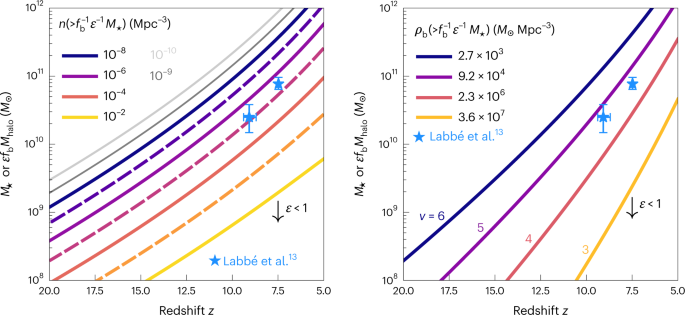2023-04-13 テキサス大学オースチン校(UT Austin)
これらの銀河候補は、大爆発後約5億年から7億年の間に観測され、太陽の質量よりも10億倍以上も重い。これは、現在の宇宙論モデルに照らしても非常に異常であり、銀河がこれほど早く形成されるには、ほぼ100%のガスが恒星に変換される必要がある。
研究者は、銀河が形成される早い方法が現在のモデルよりも存在する可能性があると考えており、宇宙論の修正が必要になる可能性があると述べている。しかし、これらの銀河候補の正確な年齢や質量を確認するためには、スペクトル分析のフォローアップ確認が必要である。
<関連情報>
- https://news.utexas.edu/2023/04/13/james-webb-space-telescope-images-challenge-theories-of-how-universe-evolved/
- https://www.nature.com/articles/s41550-023-01937-7
高赤方偏移銀河候補によるΛCDMのストレステスト Stress testing ΛCDM with high-redshift galaxy candidates
Michael Boylan-Kolchin
Nature Astronomy Published:13 April 2023
DOI:https://doi.org/10.1038/s41550-023-01937-7

Abstract
Early data from the James Webb Space Telescope (JWST) have revealed a bevy of high-redshift galaxy candidates with unexpectedly high stellar masses. An immediate concern is the consistency of these candidates with galaxy formation in the standard ΛCDM cosmological model, wherein the stellar mass (M⋆) of a galaxy is limited by the available baryonic reservoir of its host dark matter halo. The mass function of dark matter haloes therefore imposes an absolute upper limit on the number density n (>M⋆, z) and stellar mass density ρ⋆ (>M⋆, z) of galaxies more massive than M⋆ at any epoch z. Here I show that the most massive galaxy candidates in JWST observations at z ≈ 7–10 lie at the very edge of these limits, indicating an important unresolved issue with the properties of galaxies derived from the observations, how galaxies form at early times in ΛCDM or within this standard cosmology itself.



